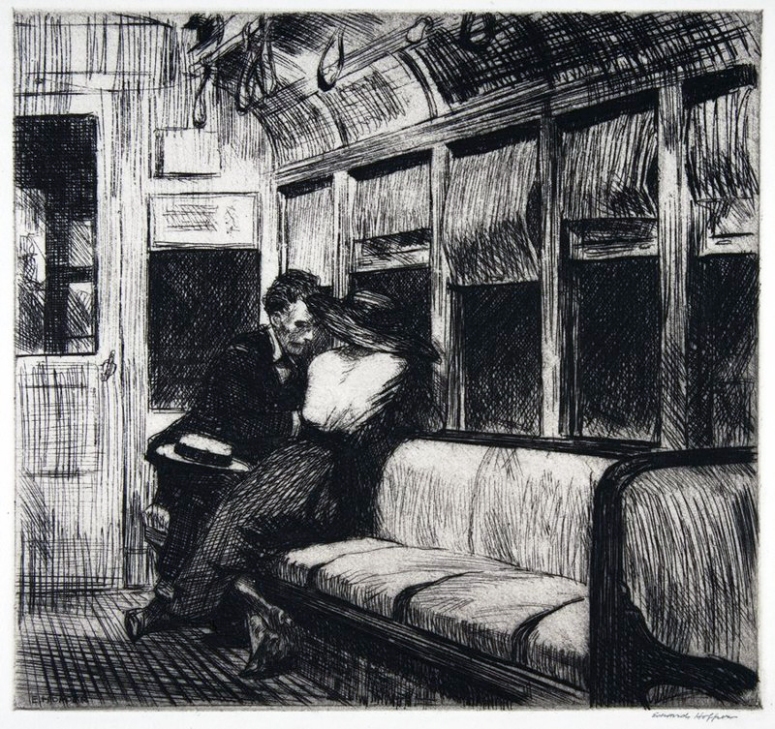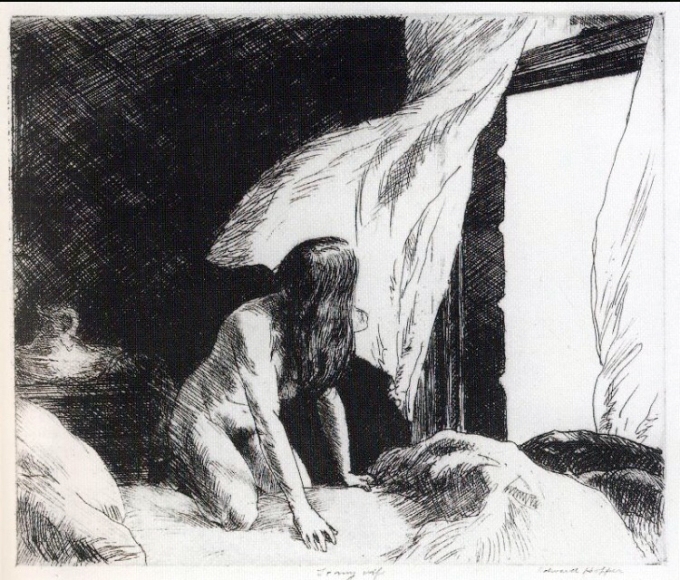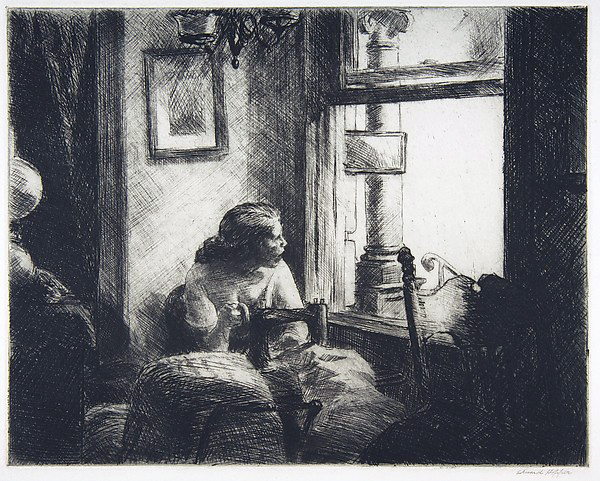Hopper never liked to characterize himself as an illustrator or printmaker, preferring to be known as a painter, but he did find commercial success and a livelihood through both of these downplayed endeavours. He began working as an illustrator in 1905 with C.C. Phillips & Co., New York, and supplemented his income with illustration work through the early 1900s. He did not find sound financial footing through sales of his paintings until after 1924, following an exhibition of his work at the Rehn Gallery in New York.
His first foray into printmaking came in 1915 at the encouragement of fellow illustrator Martin Lewis, who instructed him on the technical aspects of the medium. Their styles were markedly different: Lewis employed a variety of complicated techniques to obtain his desired tonal effects, while Hopper had a much simpler approach, only ever working in etching and drypoint. Lewis focused on printmaking throughout his artistic career, while Hopper’s period as an engraver was particularly short, and essentially ended in 1923 (in 1928 he made his final prints, two drypoints, before abandoning printmaking altogether).
Hopper had a steadfast preference when it came to this kind of works: very black ink on very white paper, plates that were deeply bitten and clean-wiped, which produced impressions that came out inky with brilliant contrasts. While creating seemingly straightforward, realist compositions, he imbued his scenes with mood and emotion, aptly capturing the intangible quality of a fleeting moment.
Here I show and comment three excellent examples:
1. Night on the Train (1918)

–
There is a pleasant air of intimacy and confidence about this couple. Man and woman are leisurely talking in confidence, maybe commenting something that the man holds in his hands or just sharing some private thought. The man is silently musing while the woman talks or has just talked. The five windows just by them are open to the night outside. We feel at once that these persons are apart in their corner, but not alone in the wagon… since ourselves are there looking at them and, what’s more, interested in them.
The bodily posture of both is masterly accomplished. All around them, the lines that depict all objects and surfaces are more vacillating, without a firm orientation, suggesting the lateral rolling of the train and also its probable movement toward us.
–
2. Evening Wind (1921)

–
This scene can be regarded as a modern-day Annunciation. Although the figure might be getting out of bed to close the window, her orientation suggests that she might also be climbing into the bed, while her nudity indicates her vulnerability and possible receptivity to the wind, which could be viewed as a symbol of some spirit or ghost -even the Holy Ghost.
Alternatively the subject could represent a version of Annunciation’s pagan counterpart: the story of the seduction of Danae by Zeus who appears as a shower of gold.
Hopper’s technique creates a sharp contrast between the darkness of the heavily crosshatched background and the untouched white paper of the space outside the window, and the area of the scene is so shallow that the viewer feels a physical closeness to the woman, as if present in the room with her; just at the other side of the bed.
–
3. East Side Interior (1922)

–
We have a window again (again, open) as the mainspring of this third scene. A woman is working indoors, eagerly sewing; all the light comes from outside -and possibly all the nice live and movement. The figure’s expression is a little tense and surly, wishful too, and also startled in this very moment by something she sees. I guess she would rather be out there, enjoying herself, than in this dark interior.
I like much the detail of the frame on the wall behind not hanging straight, because this adds somehow to the hasty and not very comfortable atmosphere of the scene.
–
Years later, Edward Hopper would tend to depict in his oils and watercolours quiet figures in serene -and lonely- environments. His engravings have more live and movement, but the loneliness is always the same. Very few other 20th century painters that I know of illustrated solitude as often and as poignantly as Hopper did, and maybe for this I like him so much.

💙💚❤💛💜 !!
LikeLiked by 1 person
There is something about black and white sketches that brings out the life in such pictures………..
LikeLiked by 1 person
I love these!!! Thank you, phral !
LikeLiked by 1 person
Ostres, molt interessants! Ha estat curiós perquè jo també m’he fixat en el quadre lleugerament mogut del tercer dibuix abans de llegir el teu últim apunt, ha ha ha. Tal com jo m’he imaginat l’escena a la primera ullada, la noia podria estar mirant els seus germans, potser jugant o fent trapelleries al carrer, enutjada i una mica envejosa al veure’ls tan despreocupats mentre ella ha d’estar cosint tancada a casa…
LikeLike
Molt bona pensada, de debò ! A mi no se m’ha acudit, però segur que ho hauria escrit 🙂 I això del quadre… m’imagino que aquells que som una mica neuròtics ho veiem abans que cap altra cosa. Haha.
M’alegro que t’hagin agradat el gravats, i moltès mercès pels commentaris !
LikeLiked by 1 person
Gràcies a tu! 😀
LikeLiked by 1 person